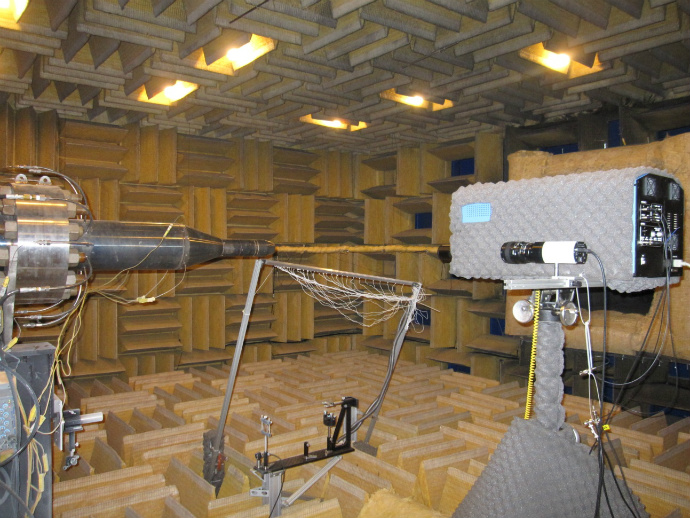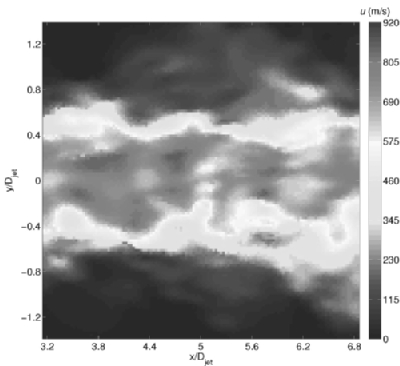Application of MHz frame rate, high dynamic range particle image velocimetry to a high-temperature, shock-containing jet
- Students: R. Harris Haynes and Bryan Brock
- Collaborators: National Center for Physical Acoustics (NCPA) on the campus of the University of Mississippi and the University of Texas-Austin.
- Funding Agency: Office of Naval Research, Jet Noise Reduction Program
A collaborative effort to investigate the turbulence associated with jet noise generation is currently underway at the National Center for Physical Acoustics (NCPA) on the campus of the University of Mississippi. For its connection with the Jet Noise Reduction program of the Office of Naval Research, jet noise corresponds to the high-amplitude sound generated by air-breathing propulsion systems, namely low-bypass turbine engines. At present it represents one of the most acute noise sources for the Department of Navy and has been linked to adverse biological, mechanical, and environmental effects. Such effects include but are not limited to the noise-induced hearing loss of Navy personnel, the structural degradation of Naval airframes, and the restriction of maintenance, testing, and training schedules due to noise pollution in communities surrounding Naval installations. To counteract these issues and combat the problem of jet noise, attempts are being made to realize and establish jet noise reduction technologies through coordinated science efforts.
At the NCPA, particle image velocimetry (PIV) as well as synchronous near-field and far-field acoustic measurements are being acquired to better quantify the noise generated by supersonic flows emanating from converging-diverging nozzles. Such noise is associated with typical variable-area nozzles found on modern, high-performance, military aircrafts. The cumulative data from these studies provides temporally resolved, synchronous characterization of the near-nozzle velocity field, the hydrodynamic pressure field, and the acoustic far field. By studying the noise-generating features of high-temperature, shock-containing jets using several measurement techniques, the hope is that a better understanding of near-nozzle flow conditions and their impacts on jet noise radiation can be obtained.
The primary focus of current research involves the acquisition and processing of temporally resolved PIV data. An imaging system unique to Auburn University has been developed through the combined use of a pulse burst laser and a high-speed gated intensified CCD framing camera. This system enables velocity-field data to be recorded at rates in excess of 1 million frames per second. Because several images can be recorded at varying time intervals with respect to one another, high dynamic range (HDR) PIV is possible. This technique enables a single velocity field to be constructed entirely from the local evaluations of multiple image pairs. Depending on the local velocity, the number of image pairs utilized for a single vector evaluation is variable. The increased dynamic velocity range that can be achieved compared to conventional PIV allows improved measurements to be obtained. At present work is being done to develop, validate, and implement a novel HDR processing scheme into the experimental data analysis.

Experimental setup in the test chamber of the Anechoic Jet Laboratory. A high-speed camera records images of particles seeded in the supersonic jet. Subsequent analysis of these images yields velocity-field measurements based on the observed displacements of the particles with time.
 |
 |
| Streamwise velocity fields for an overexpanded jet determined by HDR PIV. Spatially these results are located at increasing distances downstream of the nozzle exit. The particle images used to obtain these results were synthetically generated based on computational fluid dynamics data. | |
For more information:
- Haynes, R, Brock, B., and Thurow, B., “Application of MHz frame rate, high dynamic range PIV to a high-temperature, shock-containing jet”, AIAA Paper 2013-0774, 51st AIAA Aerospace Sciences Meeting, Grapevine, TX, January 2013
- Murray, N., Lyons, G., Tinney, C.E., Donald, B., Baars, W., Thurow, B., Haynes H., Panickar, P., “A laboratory framework for synchronous near/far-field acoustics and MHz PIV in high-temperature, shock-containing jets”, Proceedings of the Internoise 2012/ASME NCAD meeting, New York City, U.S.A., August 2012.



